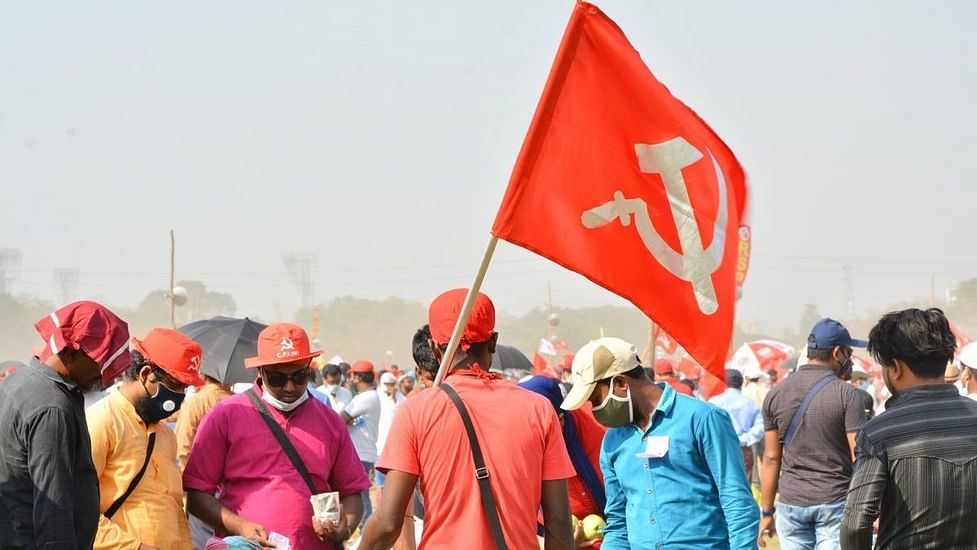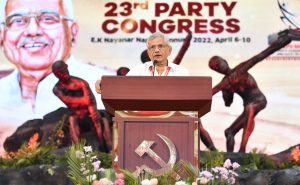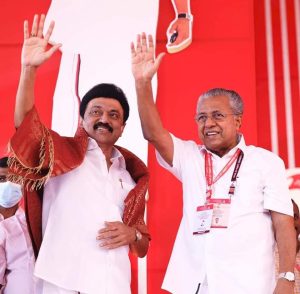
It is time for India's communist parties to reinvent or perish

The self-appraisal of the CPI (M) in its 23rd party congress in Kannur earlier this month was a reiteration of what is already an established fact.
“The party is facing the most challenging situation since its formation in 1964. Two out of the three strong bases of the party – West Bengal and Tripura – are under severe attack and there has been erosion in our mass base and influence. There is a general decline in strength of the party all over the country, with the exception of Kerala,” read an internal report of the party accessed by The Federal.
The decline of the Left in the present socioeconomic context of India has baffled many political pundits, and even communist leaders, as one would perceive that the overall scenario in the country – with growing inequality, unemployment, farm unrest and privatisation of public sector undertakings – is otherwise suitable for communism to flourish.
Stating that India is a “poor and very unequal country, with an affluent elite”, the latest World Inequality Report 2022 points out that 57 per cent of the India’s national income in 2021 was held by top 10 per cent, while the bottom 50 per cent owned almost nothing, sharing merely 13 per cent of the wealth.
An Oxfam report in January this year found that the number of billionaires grew from 102 to 142 during the pandemic, and that from March 2020 to November 30, 2021, their wealth increased from ₹23.14 lakh crore to ₹53.16 lakh crore. On the other hand, the report revealed that more than 4.6 crore Indians were estimated to have fallen into extreme poverty in 2020.
Unemployment rate in the country in March this year, according to the Centre for Monitoring Indian Economy, was 7.6 per cent. It was 4.9 per cent in 2013-14 fiscal, according to the Labour Bureau.
The Union government in its budget 2022-23 set a disinvestment target of ₹65,000 crore, which it proposes to achieve by launching Life Insurance Corporation’s initial public offering and gradually privatising 36 public sector companies, raising the spectre of forced retirement, job and wage cuts.
And although the three contentious farm laws have been rolled back after a prolonged protest, the core demands of the farmers are yet to be fulfilled.
Crores of workers joined the two-day nationwide strike beginning March 28 called by the central trade unions to protest against the government’s policies that are allegedly affecting farmers and workers, besides common people.
That the Left parties miserably failed to take advantage of the situation has been apparent from the dwindling membership of the CPI (M), the largest communist party of India. The party’s membership dropped from over 10.25 lakh in 2017 to about 9.85 lakh in 2021. Just for context, the BJP has around 18 crore members.
Now that the CPI (M), which in the past refused to read the writing on the wall, has finally admitted the harsh reality confronting it, one wonders if it will lead to a course correction.

The five-day conclave in Kannur that ended with a resolution to defeat the BJP by mobilising all “secular and democratic forces” without any political alliance with the Congress party, failed to chart any concrete revival strategy, many CPI (M) leaders claimed in private.
In its two earlier congresses, at Visakhapatnam in 2015 and Hyderabad in 2018, the party took similar resolutions, but failed to make any headway to stop the BJP’s growth and to unite the secular democratic forces, as the party itself is confused over the composition of the non-BJP secular and democratic forces it wants to rally together.
On the ground, except for Tripura, which accounts for only two Lok Sabha seats, the CPI (M) is nowhere a challenger to the BJP. Its main electoral rivals are the Congress in Kerala and the TMC in West Bengal. The two states together contribute 62 Lok Sabha seats.
To stitch a non-BJP front by leaving out both the Congress and the TMC does not seem to be a practical proposition. The party’s confusion over the issue was reflected in the 2021 West Bengal elections where it compromised its position as a “defender of the secular democracy” by taking a stand that there was collusion between the TMC and the BJP to create a bipolarity in the state, the party’s internal report admitted.
As a result of the strategic mistake, for the first time after independence, the Left failed to win a single seat in the West Bengal assembly. But despite that historic defeat, the Left parties for all practical purposes could not shun their anti-TMC stand in the state for the sake of preventing the BJP’s growth.
The CPI (M)’s biggest challenge is how to take on the BJP by rallying together other secular forces without compromising on its own political future.
“This is the one dilemma the Left in India has been facing since the country’s first general elections – conducted in 68 phases between October 25, 1951, and February 21, 1952 – wherein the undivided Communist Party of India (CPI) emerged as the main opposition party to the Congress, winning 16 seats, contesting 49,” said journalist and political commentator Probir Pramanik.
The party won eight seats in the state of Madras, which comprised present-day Tamil Nadu and Andhra Pradesh, five seats in West Bengal, two seats in Tripura and one seat in Orissa (now Odisha). More importantly, it finished second in 19 other seats in Bombay, Madhya Pradesh, Orissa, Punjab, UP, West Bengal, Mysore (now Karnataka), Manipur and Ajmer (which was a state before its merger with Rajasthan following the States Reorganisation Act, 1956).
The CPI’s performance was remarkable because a ban on it was lifted just before the election and many of its functionaries were languishing in jails during the polling, affecting its campaign. Yet the party could make its electoral presence felt almost across India.
In its review report after the elections, Pramanik said, the CPI called for a broad coalition of all Left and democratic forces that were opposed to the Congress as well as the Hindu right, then represented by the Hindu Mahasabha.
In the report, the party admitted that despite its inherent differences with Jayaprakash Narayan’s Socialist party, it should have supported the socialist candidates in the constituencies in which they were stronger for the sake of defeating the Congress and the Mahasabha, Pramanik said.
“Despite the admission, both the CPI and the Socialist could not overcome their differences for a common cause. It’s to be seen whether the Left could overcome similar differences with the parties like the TMC, for the sake of defeating the BJP. Unless it does, an all-encompassing secular front is not possible,” he added.
When it comes to coalition politics, particularly at the national level, the CPI (M) always failed to make a pragmatic choice, severely impacting its growth. For instance, in 1996 the party refused to join the United Front government at the Centre, thus missing an opportunity of having a communist prime minister in the country for the first, and probably the last, time.
After the 2004 election when the left parties with a record 61 seats became the anchor of a Congress-led United Progressive Alliance, the CPI (M) refused to join the government, losing out the opportunity of getting some lucrative ministerial berths that could help the party expand its base.
After much persuasion from the Congress, the CPI (M) agreed to let its senior leader Somnath Chatterjee be elected as the speaker. But even before the UPA government could complete its full five-year term, the CPI (M)-led Left parties withdrew support in 2008 over the Indo-US nuclear deal. In the subsequent trust vote in which the UPA government managed to prove its majority with support from Mulayam Singh Yadav’s Samajwadi Party, the Left parties and the BJP were on the same side.
The decision proved a disaster for the Left parties in the general election a year later. Their tally dropped to 22 in 2019. In West Bengal, the result heralded the beginning of the end of the Left era. The Left Front managed to win only 15 seats out of 42. The TMC emerged as the single largest beneficiary winning 19 seats.
It was the slew of projects that the TMC leader Mamata Banerjee announced for West Bengal after becoming the railway minister in the second UPA government that enhanced her acceptability in the state. Three years later, riding on the success of her anti-land acquisition movements, she dethroned the CPI (M)-led Left Front government, which had ruled West Bengal for a record 34 years, becoming the longest surviving democratically elected communist regime in the world.
The Left’s failure to gain from coalitions with the non-communist parties can also be seen in many states. For instance, in Tamil Nadu, where the party had a strong presence till the 1980s, it failed to grow beyond a few constituencies.
“Things began to go wrong in the context of the alliance politics that the communists began to play in Tamil Nadu. Through the 1970s and 1980s they remained anti-Congress. They switched sides depending on which of the two Dravidian parties was contesting against the Congress. Electorally this paid them dividends initially. In the 1980s the communists had a strong presence with about 11 MLAs. But ultimately when they began to be seen as an entity that was running between the two Dravidian parties, they began to lose out,” said Prof V Krishna Ananth, author of India Since Independence: Making Sense of Indian Politics.”
But more than its failure to adapt to the reality of the country’s coalition politics, the Left suffered from its inability to understand the social milieu of the country.
“Indian Left does not address the issues of downtrodden masses and the oppressed class. They only cater to the needs of the organised working class and the middle class,” said Dr M Kunjaman, a Dalit scholar and a professor at Tata Institute of Social Sciences.
“Class exploitation is not the only form of abuse in India. Oppression on the basis of caste and gender is more pervasive in the Indian context. The Left in India only talks about the organised working class and not about the downtrodden mass and the deprived class,” he said.
The All-India Forward Bloc general secretary Debabrata Biswas, whose party is a constituent of the Left Front in West Bengal, endorsed Dr Kunjaman’s view.
“In India the communist or the Left movements did not flourish because we failed to understand the Indian society. The majority of the landless and oppressed people in India are Dalits and people from the so-called lower castes. Most poor in the country are also from this segment of the people. We should have realised that in Indian context class and caste are synonyms,” Biswas said.
Of late, the CPI (M) has tried to address gender and caste issues by inducting more women and Dalit members in the party fold.
Quotas for women in some state committees have resulted in improvement of female representation in the party, claimed the party’s internal report. In states like Kerala, Tamil Nadu, Andhra Pradesh, Delhi, Jharkhand and Karnataka, the party’s female membership had increased substantially.

Further, for the first time in its history, the CPI (M) elected a Dalit, Ram Chandra Dome, in the party’s politburo at Kannur.
The Forward Bloc leader said that more needed to be done, pointing out that very few local secretaries or district-level leaders of the communist parties are from Dalit communities. “If we had realised that caste and class are inter-related and addressed the issue accordingly, there would not have been the growth of caste-based parties in the country,” he added.
Another factor that impeded the growth of communism in India, according to a social scientist and a former register of the Calcutta University, Rajagopal Dhar Chakraborty, was the stronghold of religion on Indian people.
“The communist parties’ oppositional stance towards religion is seen as an antithesis to Indian culture. On top of that their alleged loyalty to either Moscow or Beijing has further harmed their cause,” he said.
So much so that a Left Front constituent, the Forward Bloc, has now become wary of its communist identity. To shed its communist tag, the party has decided to drop the “hammer and sickle” that was inserted in 1952.
It will now retain its original flag with the “leaping tiger” symbol selected by its founder Subhas Chandra Bose.
“The symbol of ‘hammer and sickle’ in the party flag and its proximity to communist parties have lent credence to the propaganda that the Forward Bloc was more a communist party than a socialist one,” Biswas said. “This credence somehow blocked the path of the Forward Block to grow as an independent socialist party.”
It’s time for the communists to reinvent or perish.
(With inputs from Premshanker V in Chennai)

